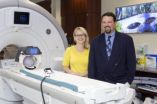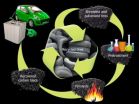(Press-News.org) A Bronze Age palace excavation reveals an ancient wine cellar, according to a study published August 27, 2014 in the open-access journal PLOS ONE by Andrew Koh from Brandeis University and colleagues.
Wine production, distribution, and consumption are thought to have played a role in the lives of those living in the Mediterranean and Near East during the Middle Bronze Age (1900-1600 BC), but little archaeological evidence about Bronze Age wine is available to support art and documentation about the role wine played during this period. During a 2013 excavation of the Middle Bronze Age Canaanite palace in modern-day Israel, the researchers in this study found 40 large storage vessels in an enclosed room located to the west of the central courtyard.
An organic residue analysis using mass spectrometry revealed that all of the relatively uniform jars contained chemical compounds indicative of wine. The authors also detected subtle differences in the ingredients or additives within similarly shaped wine jars, including honey, storax resin, terebinth resin, cedar oil, cyperus, juniper, and possibly mint, myrtle, and cinnamon. The researchers suggest the detection of these additives indicates that humans at the time had a sophisticated understanding of plants and skills necessary to produce a complex beverage that balanced preservation, palatability, and psychoactivity. According to the authors, these results may contribute to a greater understanding of ancient viticulture and the Canaanite palatial economy.
Andrew Koh added, "Based on the nature of the room, it was anticipated from the beginning that residue samples extracted and studied under virtually identical circumstances with minimal variability would have the potential to reveal new and significant insights from both a scientific and archaeological perspective. We believe this study will not only change our understanding of ancient viticulture and palatial social practices, but also the manner in which we approach organic residue analysis (ORA) as an integrated, qualitative, and interdisciplinary exercise that is as field dependent as it is laboratory intensive."
INFORMATION:
In your coverage please use this URL to provide access to the freely available paper: http://dx.plos.org/10.1371/journal.pone.0106406
Citation: Koh AJ, Yasur-Landau A, Cline EH (2014) Characterizing a Middle Bronze Palatial Wine Cellar from Tel Kabri, Israel. PLoS ONE 9(8): e106406. doi:10.1371/journal.pone.0106406
Funding: This work was supported by Brandeis University, University of Haifa, George Washington University, National Geographic Society, Israel Science Foundation, Institute for Aegean Prehistory, and Bronfman Philanthropies. The funders had no role in study design, data collection and analysis, decision to publish, or preparation of the manuscript.
Competing Interests: The authors have declared that no competing interests exist.
Bronze Age wine cellar found
Wine residue, herbal additives found in palace cellar jars
2014-08-27
ELSE PRESS RELEASES FROM THIS DATE:
Xenon exposure shown to erase traumatic memories
2014-08-27
Belmont, MA — McLean Hospital researchers are reporting that xenon gas, used in humans for anesthesia and diagnostic imaging, has the potential to be a treatment for post-traumatic stress disorder (PTSD) and other memory-related disorders.
"In our study, we found that xenon gas has the capability of reducing memories of traumatic events," said Edward G. Meloni, PhD, assistant psychologist at McLean Hospital and an assistant professor of Psychiatry at Harvard Medical School. "It's an exciting breakthrough, as this has the potential to be a new treatment for individuals ...
New drug promises relief for inflammatory pain, Stanford scientists say
2014-08-27
Pain from inflammation sidelines thousands of Americans each year. Many face a tough choice: deal with the pain, take a potentially addictive opioid or use a nonsteroidal anti-inflammatory drug that may increase risk for cardiovascular disease or gastrointestinal bleeding.
Now, researchers at the Stanford University School of Medicine have discovered a compound thought to be nonaddictive and safe for the heart and gastrointestinal system that reduces inflammatory pain in mice and rats. They call the compound Alda-1.
"Finding a new pain medication is important because ...
Stone-tipped spears lethal, may indicate early cognitive and social skills
2014-08-27
Attaching a stone tip on to a wooden spear shaft was a significant innovation for early modern humans living around 500,000 years ago. However, it was also a costly behavior in terms of time and effort to collect, prepare and assemble the spear. Stone tips break more frequently than wooden spears, requiring more frequent replacement and upkeep, and the fragility of a broken point could necessitate multiple thrusts to an angry animal. So, why did early hunters begin to use stone-tipped spears?
To learn if there was a "wounding" advantage between using a wooden spear or ...
Orphaned children can do just as well in institutions
2014-08-27
DURHAM, N.C. -- The removal of institutions or group homes will not lead to better child well-being and could even worsen outcomes for some orphaned and separated children, according to new findings from a three-year study across five low- and middle-income countries.
Children in institutions are as healthy and, in some ways, healthier than those in family-based care, according to the study, which was led by Kathryn Whetten, a Duke professor of public policy and director of the Center for Health Policy and Inequalities Research (CHPIR).
In the largest and most geographically ...
Self-deceived individuals deceive others better
2014-08-27
Over confident people can fool others into believing they are more talented than they actually are, a study has found.
These 'self-deceived' individuals could be more likely to get promotions and reach influential positions in banks and other organisations. And these people are more likely to overestimate other people's abilities and take greater risks, possibly creating problems for their organisations.
The study by researchers from Newcastle University and the University of Exeter, has also found that those who are under confident in their own abilities are viewed ...
Brain networks 'hyper-connected' in young adults who had depression
2014-08-27
Depression may be better predicted and understood now that University of Illinois at Chicago researchers have discovered that young adults who previously experienced the mental illness have hyper-connected emotional and cognitive networks in the brain.
UIC researchers used functional magnetic resonance imaging to examine the brain connectivity of young adults ages 18 to 23 while they were in a resting state. Thirty unmedicated young adults who had previously experienced depression and 23 healthy controls were used in the study, which has been published online in the journal ...
Malaria symptoms fade on repeat infections due to loss of immune cells, UCSF-led team says
2014-08-27
Children who repeatedly become infected with malaria often experience no clinical symptoms with these subsequent infections, and a team led by UC San Francisco researchers has discovered that this might be due at least in part to a depletion of specific types of immune cells.
Working in Uganda, one of the most malaria-plagued nations in Africa and one in which individuals are repeatedly exposed to the malaria parasite, UCSF scientists found that a depletion of immune cells known as gamma delta T cells diminishes inflammatory responses in infected children — responses ...
Tracking spending among the commercially insured
2014-08-27
LEBANON, NH – Recent growth in health care spending for commercially insured individuals is due primarily to increases in prices for medical services, rather than increased use, according to a new study led by researchers at The Dartmouth Institute for Health Policy & Clinical Practice, published in the August issue of the American Journal of Managed Care.
There is increasing concern that consolidation in the health care marketplace will lead to increased prices faced by payers and, ultimately, consumers," said Carrie Colla, PhD, assistant professor at The Dartmouth ...
Encyclopedia of how genomes function gets much bigger
2014-08-27
A big step in understanding the mysteries of the human genome was unveiled today in the form of three analyses that provide the most detailed comparison yet of how the genomes of the fruit fly, roundworm, and human function.
The research, appearing August 28 in in the journal Nature, compares how the information encoded in the three species' genomes is "read out," and how their DNA and proteins are organized into chromosomes.
The results add billions of entries to a publicly available archive of functional genomic data. Scientists can use this resource to discover ...
Rubber meets the road with new ORNL carbon, battery technologies
2014-08-27
OAK RIDGE, Tenn., Aug. 27, 2014 – Recycled tires could see new life in lithium-ion batteries that provide power to plug-in electric vehicles and store energy produced by wind and solar, say researchers at the Department of Energy's Oak Ridge National Laboratory.
By modifying the microstructural characteristics of carbon black, a substance recovered from discarded tires, a team led by Parans Paranthaman and Amit Naskar is developing a better anode for lithium-ion batteries. An anode is a negatively charged electrode used as a host for storing lithium during charging.
The ...
LAST 30 PRESS RELEASES:
Sleeping in on weekends may help boost teens’ mental health
Study: Teens use cellphones for an hour a day at school
After more than two years of war, Palestinian children are hungry, denied education and “like the living dead”
The untold story of life with Prader-Willi syndrome - according to the siblings who live it
How the parasite that ‘gave up sex’ found more hosts – and why its victory won’t last
When is it time to jump? The boiling frog problem of AI use in physics education
Twitter data reveals partisan divide in understanding why pollen season's getting worse
AI is quick but risky for updating old software
Revolutionizing biosecurity: new multi-omics framework to transform invasive species management
From ancient herb to modern medicine: new review unveils the multi-targeted healing potential of Borago officinalis
Building a global scientific community: Biological Diversity Journal announces dual recruitment of Editorial Board and Youth Editorial Board members
Microbes that break down antibiotics help protect ecosystems under drug pollution
Smart biochar that remembers pollutants offers a new way to clean water and recycle biomass
Rice genes matter more than domestication in shaping plant microbiomes
Ticking time bomb: Some farmers report as many as 70 tick encounters over a 6-month period
Turning garden and crop waste into plastics
Scientists discover ‘platypus galaxies’ in the early universe
Seeing thyroid cancer in a new light: when AI meets label-free imaging in the operating room
Neutrophil-to-lymphocyte ratio may aid risk stratification in depressive disorder
2026 Seismological Society of America Annual Meeting
AI-powered ECG analysis offers promising path for early detection of chronic obstructive pulmonary disease, says Mount Sinai researchers
GIMM uncovers flaws in lab-grown heart cells and paves the way for improved treatments
Cracking the evolutionary code of sleep
Medications could help the aging brain cope with surgery, memory impairment
Back pain linked to worse sleep years later in men over 65, according to study
CDC urges ‘shared decision-making’ on some childhood vaccines; many unclear about what that means
New research finds that an ‘equal treatment’ approach to economic opportunity advertising can backfire
Researchers create shape-shifting, self-navigating microparticles
Science army mobilizes to map US soil microbiome
Researchers develop new tools to turn grain crops into biosensors
[Press-News.org] Bronze Age wine cellar foundWine residue, herbal additives found in palace cellar jars


